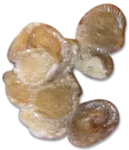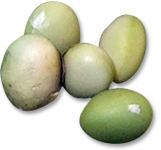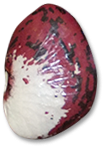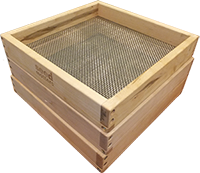 Seed Saving
Seed Saving
Information provided by White Earth Seed Library.
Seeds are living, hibernating embryos. They have a life span and survive longest if kept cool, dark and dry.
Types of Pollination
Pollination - is the process of sexual fertilization in plants. The different methods a flower uses for pollination will dictate the spacing or isolation necessary for plants to produce dependable seeds.
Self-Pollination occurs without need for other flowers or plants because it takes place within the flower before it opens. Isolation distance to prevent cross-pollination is not necessary.
Cross-Pollination takes place when pollen is exchanged between different flowers on the same or different plants. If not prevented, unwanted characteristics and traits may result in the offspring. Any crop cross-pollinated between two different plant varieties is called a hybrid.
| Tomato | Soy Beans | Potawatomi Lima Bean | Squash |
|---|---|---|---|
 |
 |
 |
 |
Types of Seed
Open-Pollinated or Heirloom varieties have been grown for so many generations that their physical and genetic qualities are relatively stable. This is the result from the pollination occurring between the same or genetically similar parents. The seeds will be "true-to-type" if saved. Not hybrid
Hybrids - are varieties resulting from pollination between genetically distinct parents. If a seed packet has hybrid, F1, or VF written on it. Hybrids will not produce plants like the parents. They can be sterile or produce a majority of offspring unlike themselves because they are genetically unstable.
Plant Families
If you learn the Family, Genus and Species of your fruits and vegetables, you will also learn their basic seed saving needs and risks.
Families define the basic form of the flower parts of plants. All plants with the same flower (and reproductive) structure are in the same family.
Genera (singular Genus) define more closely related plants. Crosses between genera are rare but can occur.
Species define specific botanically recognized plants with similar fruit, flowers, and leaves. Plants within one species will readily cross with each other.
Cultivars are cultivated varieties that can cross with each other when they are in the same species. When we save seeds we usually want to maintain a cultivar or breed a new one.
 Example:
Example:
Family: Cucurbitaceae
Genus: Curbita
Species: curbita peop (scientific name)
Cultvars: acorn squash, Water gourd
Squash and gourd are the same species and can easily cross-pollinate, which might result in an inedible variety if grown closer than their isolation distance. That is why they are labeled "advanced".
How it works
"Easy" Seeds
Plants in these families are mostly self-pollinating and annuals (they seed the same year). Seeds are reliably the same as the parent plant. This includes;
Fabaceae family; Beans, Pease, Lentil
Solanaceae family; Tomatoes, Peppers, Eggplants and Tobacco.
Asteraceae family; Lettuce, Sunflowers, Jerusalem artichoke.
"Medium" Seeds
The seeds in this section tend to be biennials meaning they produce seeds in the second growing season. These plants also tend to cross-pollinate with other plants. This includes:
Alliaceae family; Onions, Garlic, Chives - Biennials.
Amaranthaceae family; Amaranth, Beets, Chard, Spinach
Umbelliferae family; Carrot, Celery, Dill, Fennel, Parsley, Parsnip
"Advanced" Seeds
The seeds that are labeled "advanced" require special planning and attention to preserve varietal purity. Be mindful of Isolation distances. Isolation distance is the minimum distance between two different flowers to prevent pollen from being exchanges. Wind pollination is pollination caused by wind. Insect pollination is pollination caused by insects, primarily bees. The plants in this section will readily cross with unseen nearby plants. Corn has an isolation distance of two miles. Some of the varieties may require hand pollination depending on location. It is always a good idea to ask your neighbors what they are growing and be observant. This includes;
Brassicaceae family; Broccoli, Kale, Kohlrabi, Cabbage, Cauliflower, Turip, Collards
Cucurbitaceae family; Cucumbers, melons, Squash, Pumpkin, Gourds
Poaceae family; Barley, Corn, Kamut, Oats
How to Process & Store Seeds
Dry Seed Processing: This refers to seeds partially dry while still on the plant. The seeds are collected before the seed head opens. You can harvest them by cutting the seed stalk off the plant. You may put them in a paper bag to dry fully.
Wet Seed Processing: The seeds are scooped out of the fully ripe or overripe fruit, rinsed to remove pulp, and spread out on a cookie sheet, on wax paper or screen to dry. Avoid paper or cloth as seeds will stick and dyes may be transferred.
Fermenting of Seeds: The process of saving seeds that are surrounded by a gel-sack which contains germination inhibitors. The seeds of this fruiting body are squeezed into a glass container and covered with water. The container is left out at room temperature for 1-3 days. A layer of mold will form at the top and the gel sack will have broken down. Toss away any floating seeds. Then clean the good seeds by dumping the moldy water and swishing new water around the seeds a few times. Then, spread out the seeds on a paper to dry and put in a paper envelope.
Seeds store best when cool and dry. Humidity and heat destroys seeds. You may place seeds in the freezer for a few days to kill any pests after the seed in completely dry. You may store seeds in a glass jar in the refrigerator or freezer, but remember not to open the jar until it reaches room temperature. The easiest way is to place seeds into an envelope because if the seeds are not completely dry, they will continue to dry out in the envelope. You may put seeds in clay or metal cans as well. Research has shown at 80 degrees seeds really start to die fast.
Seed Saving Tips
To preserve genetic diversity, plants have optimal population sizes. If your plant needs a larger population to prevent inbreeding depression then team up with neighbors, community garden or seed swap with someone else growing the same plant.
The squash we commonly grow in our gardens fall into one of three species; Cucurbita maxima, Curbita moschata, cucurbita pepo. These different species will not cross-pollinate with each other. Yet food crops that look quite different from each other such as broccoli, brussels sprouts, cabbage, cauliflower, collards, kale, and kohlrabi will ALL cross-pollinate because they are varieties of the same species, Brassica oleracea.
An isolation distance chart should be checked when taking out seeds to prevent cross-pollination.
Know the life cycle of the food crop you grow. One way to prevent unwanted cross-pollination is to plant varieties of the same species at different time intervals. They will flower weeks apart and not cross pollinate. The pollination period is just a small window of time. (From a day up to a week form most plants). It only last right after the flowers open.
Don't save seeds from hybrids, unless you're an advanced seed saver and understand the experiment you are undertaking.
Keep a journal. Write when you planted the seeds, the weather conditions of that season, location, and when you harvested. This activity will help you learn from your plants and help keep varieties that work best for your location and microclimates.
Seed Storage Information
Storage Temperature must be derived from this formula when assessing storage unit effectiveness:
°F + RH ≤ 100
Lower relative humidity means higher allowable storage temperatures, as long as their sum does not exceed a combined value of 100. For example, storage areas with an RH value of 60% need to be cooled to 40° F to enhance maximum storage potential. Higher temperatures can be especially damaging if the seed is stored at higher moisture contents. Seed stored with lower moisture contents may tolerate higher temperatures better.
| Seed | Years |
|---|---|
| Bean | 2-3 |
| Soybean | 2-3 |
| Beed/Chard | 3-5 |
| Broccoli/Kale | 3-5 |
| Cauliflower | 3-5 |
| Carrot | 2-3 |
| Celery | 2-3 |
| Corn | 2-3 |
| Cucumber | 5-10 |
| Eggplant | 2-3 |
| Seed | Years |
|---|---|
| Leek | 2 |
| Lettuce | 2-3 |
| Melon | 5-10 |
| Mustard | 3-5 |
| Onion | 1 |
| Pea | 2-3 |
| Pepper | 2-3 |
| Radish | 3-5 |
| Spinach | 2-3 |
| Squash/Pumpkin | 2-5 |
| Tomato | 5-10 |
Seed Saving Definitions
Annual - A plant that produces seed in one season and dies.
Biennial - A plant that produces seed in two years.
Perennial - A plant that may produce seed yearly and grows back year-to-year.
Land Race - A general term to describe seeds that are still being grown and saved from the area they came. Like Walthum butternut squash.
Open Pollinated - A seed that will stay true to type year to year if perserved correctly. Has stable genetics.
Heirloom - An open pollinated seed that is a "treasure" or has a name and story.
Hybrid - A cross between two inbred plants. Usually adds vigor through heretosis but will not stay true to type. Look for "F1" on packet.
Heretosis - The vigor that usually occurs when a hybird is formed.
Phenotype - Physical expression.
Genotype - Genetic expression.
Pollination - Sexual reproduction of plants.
Perfect Flowers - Bisexual flowers that can pollinate themselves, bean, peas and tomatoes.
Imperfect Flowers - Have separate M and F flowers on the same plant.
Selfer - Plants that pollinate themselves.
Outcrosser - Plants that need pollen from other male flowers, on same or dfferent plant.
Plant Species - different food crops; Tomato, Pepper, Eggplant.
Genus - Same as "variety" - ex. Type of corn, black popcorn, Pink Lady.
Isolation distance - space needed to protect unwanted hybridization.
Patent label - Look for PPV.
Resources
| Places to order Open- pollinated seeds |
Books | Movies |
|---|---|---|
| Baker Creek Seed Savers Exchange Native Seed SEARCH Seeds Trust Turtle Tree Seed Victory Seeds High Mowing Annies Heriloom Seeds Sustainable Seed Company |
Uncertain Peril - Claire Hope Cummings Breed Your Own Vegetable Varieties - Carol Deppe Botany in a Day - Thomas J. Epel Shattering - Pat Mooney & Cary Fowler Where Our Food Comes From - Gary Nabhan Breeding Organic Vegetable - Rowen White Seed to Seed - Suzanne Ashworth Beautiful Corn - Anthony Boutard Tending the Wild - Kat Anderson |
Genetic Roulette King Corn Food Inc. |
White Earth Seed Library
The seed library's mission is to preserve our ancient varieties of seeds as well as strengthening food security and nutrition in our region.
Links
White Earth Seed Library Website: anishinaabeseedproject.com
Seed Matters: www.seedmatters.org
Soil Secrets: http://soilsecrets.com
The Seed Biology Place: www.seedbiology.de
LLBO Division of Resource Management (218) 335-7400
White Earth Seed Library: [email protected]















 Division of Resource Management
Division of Resource Management